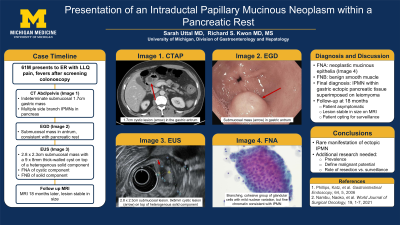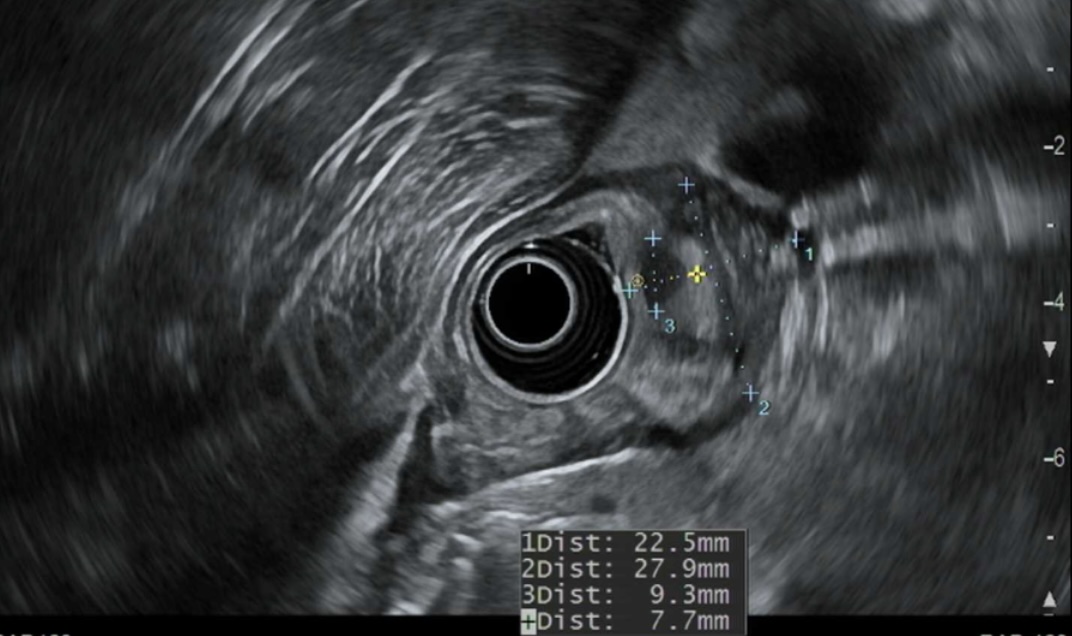Tuesday Poster Session
Category: Biliary/Pancreas
P3512 - Presentation of an Intraductal Papillary Mucinous Neoplasm Within a Pancreatic Rest
Tuesday, October 29, 2024
10:30 AM - 4:00 PM ET
Location: Exhibit Hall E

Has Audio

Sarah Uttal, MD
Michigan Medicine
Ann Arbor, MI
Presenting Author(s)
Sarah Uttal, MD, Richard Kwon, MD, MS
Michigan Medicine, Ann Arbor, MI
Introduction: Ectopic pancreatic tissue is potentially susceptible to common pancreatic disease processes, but in aberrant locations. We present a rare combination of pancreatic disease processes, including an intraductal papillary mucinous neoplasm (IPMN) on a leiomyoma, within a pancreatic rest.
Case Description/Methods: A 62-year-old man with a history of diabetes, chronic kidney disease, and recent colonoscopy with multiple sigmoid and descending colon cold snare polypectomies presented to the emergency department with abdominal pain and fevers. Cross-sectional imaging noted colitis involving 14cm of descending and sigmoid colon and incidentally noted an indeterminate 2.1cm fluid attenuated lesion of the gastric antrum, possibly a cystic gastrointestinal stromal tumor (GIST). Multiple pancreatic cysts up to 1.5cm were also noted, consistent with side branch IPMNs. The patient was treated with oral antibiotics and symptoms resolved.
Upper endoscopy (EGD) with endoscopic ultrasound (EUS) was pursued four months later to investigate the incidental gastric lesion. On EGD, a submucosal mass in the antrum was identified. Its appearance was consistent with a pancreatic rest. On EUS, the hypoechoic lesion appeared to originate in the submucosa with echogenicity similar to nearby pancreatic parenchyma. However, there was a distinct cystic component (see image). Fine needle aspiration (FNA) of the cystic component yielded mucinous epithelia consistent with an IPMN without high-grade dysplasia. Fine needle biopsy (FNB) of the solid component of the submucosal lesion was read as benign smooth muscle, consistent with leiomyoma. The patient is currently being evaluated for surgical resection.
Discussion: This case highlights the utility of EUS and FNA or FNB to elucidate etiologies of submucosal gastric masses and illustrates a most unusual presentation of a pancreatic rest comprised of IPMN superimposed on a leiomyoma. Ectopic pancreas in the stomach is easily mistaken for a GIST or leiomyoma. While ectopic pancreatic tissue is prone to the same disease processes as the native pancreas, IPMNs are exceedingly rare in ectopic pancreatic tissue with only case reports available in the literature, most diagnosed after surgical resection. Additional information regarding prevalence of IPMNs in heterotopic pancreatic tissue is needed to inform clinical decision making and best surveillance strategies for these patients.

Disclosures:
Sarah Uttal, MD, Richard Kwon, MD, MS. P3512 - Presentation of an Intraductal Papillary Mucinous Neoplasm Within a Pancreatic Rest, ACG 2024 Annual Scientific Meeting Abstracts. Philadelphia, PA: American College of Gastroenterology.
Michigan Medicine, Ann Arbor, MI
Introduction: Ectopic pancreatic tissue is potentially susceptible to common pancreatic disease processes, but in aberrant locations. We present a rare combination of pancreatic disease processes, including an intraductal papillary mucinous neoplasm (IPMN) on a leiomyoma, within a pancreatic rest.
Case Description/Methods: A 62-year-old man with a history of diabetes, chronic kidney disease, and recent colonoscopy with multiple sigmoid and descending colon cold snare polypectomies presented to the emergency department with abdominal pain and fevers. Cross-sectional imaging noted colitis involving 14cm of descending and sigmoid colon and incidentally noted an indeterminate 2.1cm fluid attenuated lesion of the gastric antrum, possibly a cystic gastrointestinal stromal tumor (GIST). Multiple pancreatic cysts up to 1.5cm were also noted, consistent with side branch IPMNs. The patient was treated with oral antibiotics and symptoms resolved.
Upper endoscopy (EGD) with endoscopic ultrasound (EUS) was pursued four months later to investigate the incidental gastric lesion. On EGD, a submucosal mass in the antrum was identified. Its appearance was consistent with a pancreatic rest. On EUS, the hypoechoic lesion appeared to originate in the submucosa with echogenicity similar to nearby pancreatic parenchyma. However, there was a distinct cystic component (see image). Fine needle aspiration (FNA) of the cystic component yielded mucinous epithelia consistent with an IPMN without high-grade dysplasia. Fine needle biopsy (FNB) of the solid component of the submucosal lesion was read as benign smooth muscle, consistent with leiomyoma. The patient is currently being evaluated for surgical resection.
Discussion: This case highlights the utility of EUS and FNA or FNB to elucidate etiologies of submucosal gastric masses and illustrates a most unusual presentation of a pancreatic rest comprised of IPMN superimposed on a leiomyoma. Ectopic pancreas in the stomach is easily mistaken for a GIST or leiomyoma. While ectopic pancreatic tissue is prone to the same disease processes as the native pancreas, IPMNs are exceedingly rare in ectopic pancreatic tissue with only case reports available in the literature, most diagnosed after surgical resection. Additional information regarding prevalence of IPMNs in heterotopic pancreatic tissue is needed to inform clinical decision making and best surveillance strategies for these patients.

Figure: EUS image of submucosal lesion with cystic component
Disclosures:
Sarah Uttal indicated no relevant financial relationships.
Richard Kwon indicated no relevant financial relationships.
Sarah Uttal, MD, Richard Kwon, MD, MS. P3512 - Presentation of an Intraductal Papillary Mucinous Neoplasm Within a Pancreatic Rest, ACG 2024 Annual Scientific Meeting Abstracts. Philadelphia, PA: American College of Gastroenterology.
